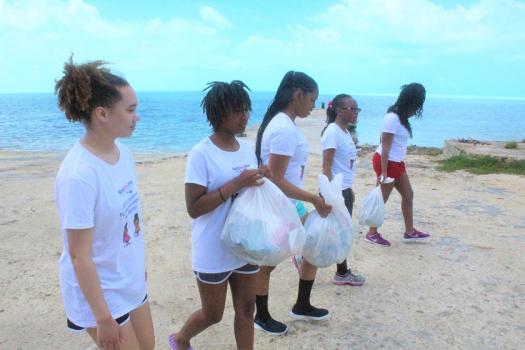From sea to shining sea: Introducing black girls to the world of marine science and diving

Historically, a number of societal and systemic barriers have barred black men and women from even enjoying an activity as simple as swimming. According to the YMCA, 64 percent of black children cannot swim and they are three times more likely to drown than white children. In the communities and circumstances black people have been confined to, they have not always had the necessary resources to learn valuable, practical skills.
Similar obstacles are a barrier to entry for many black children who wish to learn more about STEM fields. For these reasons, Nevada Winrow, a neuropsychologist working in education and member of the Women’s Diving Hall of Fame, started the Black Girls Dive Foundation, an organization dedicated to providing underserved and under-resourced girls between the ages of nine and 17 with valuable skills in STEM and aquatic-based recreation. Thanks to a STEM Action Grant provided by the Society for Science & the Public, she has been able to expand the organization’s work.
Within the last year, the Society’s STEM Action Grant has funded five field trips for a Black Girls Dive program, called STREAMS (Science, Technology, Robotics, Engineering, Art and Mathematics with Scuba Diving). The program is dynamic and designed to introduce girls to a multitude of activities including STEM and SCUBA. Program participants build underwater remotely operated vehicles (ROVs) with video recording capabilities. Using the device, the girls have an opportunity to engage in introductory underwater archeology and to study the biodiversity of ecosystems, such as reef behavior. The Society’s funding has also supported 100 hours of free STEM activities for the community, including a Roboweek, where youth learned about motors and batteries, and created their own motor-operated items. These community events act as recruitment for the program.
“The overall goal of this project was to provide STEM programming to girls who are historically underrepresented in STEM,” said Nevada. “This project empowers youth to address chronic or emerging challenges facing their communities through innovative, engaging and culturally relevant, place- and project-based learning experiences.”
In 2018, the STREAMS program has directly impacted a total of 75 young girls, 90 percent of whom come from single-parent households. The girls participated in educational field trips and SCUBA excursions, of which 90 percent of the 75 young women were able to attend. Of note, the girls have met members of the Smithsonian Scientific Diving Program, and participated in a conservation project with the National Aquarium. They also attended a conference in Washington D.C., where they shared with the public all the good the program is doing by exposing them to STEM.

The central trip the girls took, however, was part of an ocean conservation initiative called At Depth: From Sea to Shining Sea, where the girls have initiated a plan to clean up the ocean from the Atlantic to the Pacific Coast. The initiative kicked off on Andros Island off the coast of the Bahamas and home to Forfar Field Station, a field study program operated by International Field Studies. This site is where curious up-and-coming scientists can learn about topics such as marine biology, island ecology and Bahamian culture and it is also where the girls of Black Girls Dive became certified divers according to the requirements of the Professional Association of Diving Instructors (PADI). PADI certification involves a knowledge assessment to ensure the fundamentals of diving are understood, beginning with confined dives in swimming pools and finally an open water dive to put those skills to the test.
Through her organization, Nevada is influencing a new generation to take up STEM when they may not have believed they could achieve a scientific career. While participating in the program, the girls conducted research on the differences in oceanic and freshwater blue holes, a naturally occurring sinkhole that appears in underwater limestone, and attended lectures on the study of amphibians as well as fish identification. They also had the once-in-a-lifetime opportunity to swim in a blue hole and experience the phenomenon firsthand. “Because of the Society’s support, 75 people have been able to explore their STEM identities through engagement in STEM activities and mentorship from leading experts in their field,” said Nevada. “Post-survey results even showed that participants saw themselves as a scientists, as opposed to the pre-survey where they reported that they did not see themselves as scientists.”
And, the students love the program. “This program is the best thing ever. I get to brag that I know how to scuba dive and I can identify many kinds of fish!” said one participant. Another added, “I am coming back next year so I can move up a level and be in the more advanced class.”
There are many reasons to invest in the future of the underserved. Science should not be reserved as an endeavor for those with the means. Through the Society’s STEM Action Grant Program, the Society is ensuring that there is equal opportunity for budding scientists from all walks of life to achieve their full potential.
The Society aims to fund innovative organizations that support community based STEM projects, and whose work supports our mission. Apply today, deadline is May 1, 2019


